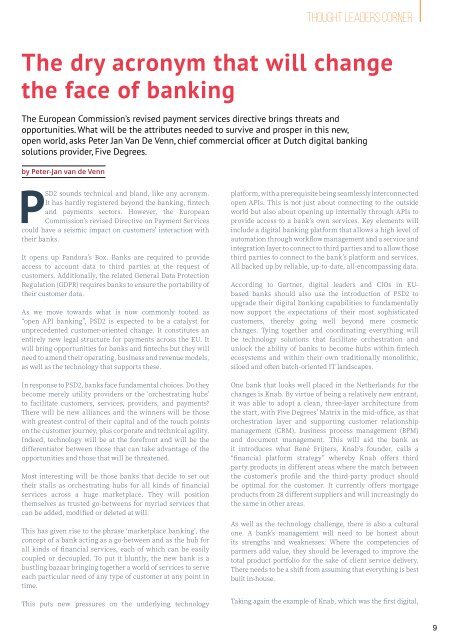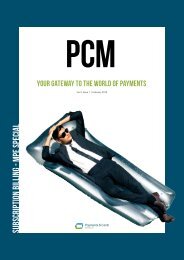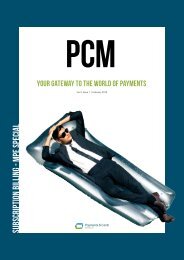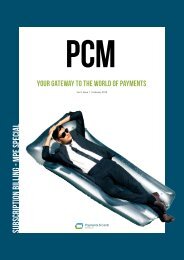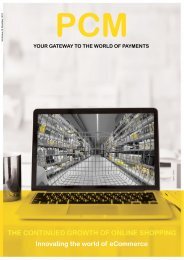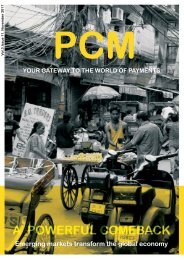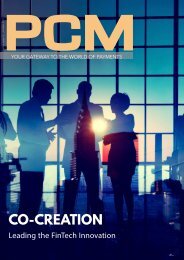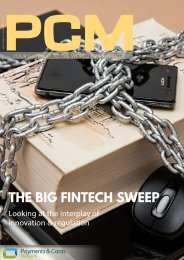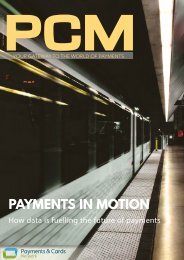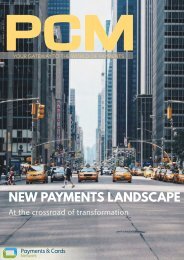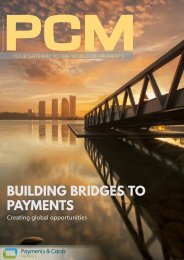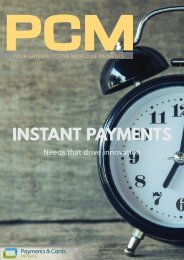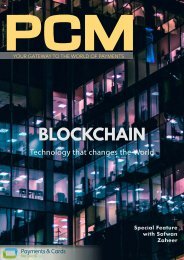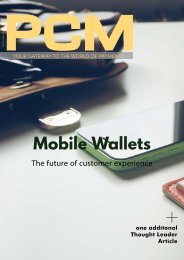PCM - MRC Vegas 2017 Issue
This is a special issue created for the MRC Vegas event in Las Vegas 2017. This special issue focuses on the major challenge of balancing the data gathering processes to provide better products & services to customer but keep their data privacy in mind at the same time
This is a special issue created for the MRC Vegas event in Las Vegas 2017. This special issue focuses on the major challenge of balancing the data gathering processes to provide better products & services to customer but keep their data privacy in mind at the same time
You also want an ePaper? Increase the reach of your titles
YUMPU automatically turns print PDFs into web optimized ePapers that Google loves.
The dry acronym that will change<br />
the face of banking<br />
The European Commission’s revised payment services directive brings threats and<br />
opportunities. What will be the attributes needed to survive and prosper in this new,<br />
open world, asks Peter Jan Van De Venn, chief commercial officer at Dutch digital banking<br />
solutions provider, Five Degrees.<br />
by Peter-Jan van de Venn<br />
Thought Leaders Corner<br />
PSD2 sounds technical and bland, like any acronym.<br />
It has hardly registered beyond the banking, fintech<br />
and payments sectors. However, the European<br />
Commission’s revised Directive on Payment Services<br />
could have a seismic impact on customers’ interaction with<br />
their banks.<br />
It opens up Pandora’s Box. Banks are required to provide<br />
access to account data to third parties at the request of<br />
customers. Additionally, the related General Data Protection<br />
Regulation (GDPR) requires banks to ensure the portability of<br />
their customer data.<br />
As we move towards what is now commonly touted as<br />
“open API banking”, PSD2 is expected to be a catalyst for<br />
unprecedented customer-oriented change. It constitutes an<br />
entirely new legal structure for payments across the EU. It<br />
will bring opportunities for banks and fintechs but they will<br />
need to amend their operating, business and revenue models,<br />
as well as the technology that supports these.<br />
In response to PSD2, banks face fundamental choices. Do they<br />
become merely utility providers or the ‘orchestrating hubs’<br />
to facilitate customers, services, providers, and payments?<br />
There will be new alliances and the winners will be those<br />
with greatest control of their capital and of the touch points<br />
on the customer journey, plus corporate and technical agility.<br />
Indeed, technology will be at the forefront and will be the<br />
differentiator between those that can take advantage of the<br />
opportunities and those that will be threatened.<br />
Most interesting will be those banks that decide to set out<br />
their stalls as orchestrating hubs for all kinds of financial<br />
services across a huge marketplace. They will position<br />
themselves as trusted go-betweens for myriad services that<br />
can be added, modified or deleted at will.<br />
This has given rise to the phrase ‘marketplace banking’, the<br />
concept of a bank acting as a go-between and as the hub for<br />
all kinds of financial services, each of which can be easily<br />
coupled or decoupled. To put it bluntly, the new bank is a<br />
bustling bazaar bringing together a world of services to serve<br />
each particular need of any type of customer at any point in<br />
time.<br />
This puts new pressures on the underlying technology<br />
platform, with a prerequisite being seamlessly interconnected<br />
open APIs. This is not just about connecting to the outside<br />
world but also about opening up internally through APIs to<br />
provide access to a bank’s own services. Key elements will<br />
include a digital banking platform that allows a high level of<br />
automation through workflow management and a service and<br />
integration layer to connect to third parties and to allow those<br />
third parties to connect to the bank’s platform and services.<br />
All backed up by reliable, up-to-date, all-encompassing data.<br />
According to Gartner, digital leaders and CIOs in EUbased<br />
banks should also use the introduction of PSD2 to<br />
upgrade their digital banking capabilities to fundamentally<br />
now support the expectations of their most sophisticated<br />
customers, thereby going well beyond mere cosmetic<br />
changes. Tying together and coordinating everything will<br />
be technology solutions that facilitate orchestration and<br />
unlock the ability of banks to become hubs within fintech<br />
ecosystems and within their own traditionally monolithic,<br />
siloed and often batch-oriented IT landscapes.<br />
One bank that looks well placed in the Netherlands for the<br />
changes is Knab. By virtue of being a relatively new entrant,<br />
it was able to adopt a clean, three-layer architecture from<br />
the start, with Five Degrees’ Matrix in the mid-office, as that<br />
orchestration layer and supporting customer relationship<br />
management (CRM), business process management (BPM)<br />
and document management. This will aid the bank as<br />
it introduces what René Frijters, Knab’s founder, calls a<br />
“financial platform strategy” whereby Knab offers third<br />
party products in different areas where the match between<br />
the customer’s profile and the third-party product should<br />
be optimal for the customer. It currently offers mortgage<br />
products from 28 different suppliers and will increasingly do<br />
the same in other areas.<br />
As well as the technology challenge, there is also a cultural<br />
one. A bank’s management will need to be honest about<br />
its strengths and weaknesses. Where the competencies of<br />
partners add value, they should be leveraged to improve the<br />
total product portfolio for the sake of client service delivery.<br />
There needs to be a shift from assuming that everything is best<br />
built in-house.<br />
Taking again the example of Knab, which was the first digital,<br />
9


